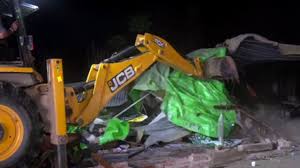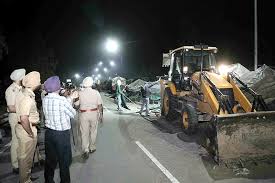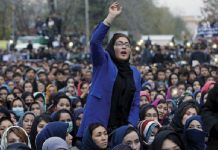The Punjab government’s action against protesting farmers, seemingly wary of the stir’s impact on the Ludhiana by-election, has sparked political ripples. With many farm leaders detained and anger mounting, the fallout could test AAP’s standing in the state. A report by Rajesh Moudgil

The eviction of the protesting farmers from the Shambhu and Khanauri barriers protest sites on two national highways in Punjab and the subsequent detention of their several senior farm leaders including Jagjit Singh Dallewal and Sarwan Singh Pandher on March 19, last, did not come as a surprise.
Nor the change of heart of the chief minister Bhagwant Mann – otherwise a staunch supporter of farmers till a month ago – was sudden. For, he had made it immensely clear to the protesting farmers over a fortnight ago that a stern action against them was on the way.
Finally, the traffic was thus resumed on the Shambhu and Khanauri stretches of the national highways after over a year of blockades by farmers.

For record, a score of farmers had been camping at the said two protest sites since February 13, 2024, to press for their various demands including MSP and debt waiver. They made several attempts to take their “Delhi chalo’’ tractor/foot march towards Delhi but the same were thwarted by Haryana police and Central forces by raining tear-gas shells leaving several of them injured as the Centre’s repeated talks with the protesting farmers last year in Chandigarh, had remained inconclusive.
However, a showdown between the farmers and state government was looming since March 4, 2025, when the meeting between the farm leaders and Mann fell through and he stormed out of the meeting after farmers told him that they would go ahead with their scheduled March 5 protest in Chandigarh, irrespective of their meeting with him.
That very night, Punjab police carried out raids across the state detaining a score of farm leaders.
After the meeting, Mann had told newspersons that he left the meeting as farmers remained adamant that they would continue their protest till their demands were met irrespective of the meeting with him. Ruing frequent protests and demonstrations in the state, he said that Punjab was turning into a “dharna state’’. He also told farm leaders that Punjab was suffering massive economic losses due to frequent road blockades or rail blockades.
The stand-off between protesting farmers and ruling Aam Aadmi Party (AAP) government escalated further as not only the AAP government thwarted the farmers from entering Chandigarh, but even detained more senior leaders Joginder Singh Ugrahan, Mukesh Sharma, Balbir Singh Rajewal and Ruldu Singh Mansa, the next day – March 5.
On March 19, Mann government got another chance when several senior farm leaders including Jagjit Singh Dallewal and Sarwan Singh Pandher were in Chandigarh to take part in the meeting with three Central ministers including Shivraj Singh Chauhan. It was the seventh round of talks between farmers and Central ministers since February, last year. The presence of farmers at the two barriers was thin.
The Punjab police, which had deployed heavy police at the two protest sites and suspended the internet services a day ago, evicted the farmers and detained some more leaders as they entered Punjab March 19 evening after attending the meeting in Chandigarh, though amid mild confrontation between the two sides.
Ludhiana by-election
The move, the political observers opine, was given a final shape after the recent meeting of the Ludhiana industrialist and traders with AAP supremo Arvind Kejriwal and Mann on March 18 last in Ludhiana, in the wake of upcoming Ludhiana west assembly by-election. This election was crucial for AAP as it had recently faced a drubbing in Delhi assembly polls.
The Ludhiana seat had fallen vacant following the death of AAP MLA Gurpreet Bassi Gogi on January 10 at his home of a gunshot injury after his licensed weapon went off accidentally.
Mann and Kejriwal were reportedly told by the business community members that AAP’s win seemed difficult because of the anger of the traders and industrialists of the state; the blocked highways at Shambhu and Khanauri barriers had been causing humungous losses to them for over a year. Political analyst Prof Ashutosh Kumar, faculty at the department of political science, Panjab University, Chandigarh, also agrees that huge financial losses to the state because of the highways’ blockade could be a reason behind the government action.
The AAP MP Gurmeet Singh Meet Hayer who held that the AAP had always supported farmers, said that due to the border closures, an environment has developed where even the industries that were established in Punjab are now leaving. He had urged the farmers to open one side of the border, stating that the BJP government sitting in Delhi will not suffer any losses due to this. Instead, it was directly harming Punjab, causing the state government to lose hundreds of crores of rupees in revenue, and industries are leaving Punjab.
Issue rocks budget session on day one
The Governor’s address on the opening day of the Punjab assembly budget session on March 21 was also marred by the Congress walkout over the police action against farmers.
Led by the Leader of the Opposition, Partap Singh Bajwa, the Congress legislators raised slogans against the ruling Aam Aadmi Party (AAP) government and entered the Well of the House amid Governor Gulab Chand Kataria’s address. It was barely a few minutes after the governor started his address, that Bajwa got up and sought his attention over the issue, besides the issue of assault of an Army Colonel by 12 Punjab police personnel in Patiala.
However, when the governor continued to read his speech, Bajwa and other Congress MLAs, who displayed placards flaying chief minister Bhagwant Mann government, entered the Well of the House and started raising slogans against the AAP government. They continued raising slogans for a few minutes before staging the walkout.
Farmers burn CM’s effigies
The farmers’ stir intensified on March 22 as several farmers’ organizations held protests against the police action and burnt the effigies of state AAP government and chief minister’s effigies. They demanded the release of the detained farm leaders and also claimed that several belongings of the farmers, such as tractors, tractor trolleys, LPG cylinders, washing machines, fans, air-conditioners, refrigerators and inverters, had gone missing from the two protest sites.
The Punjab government on March 24 released 450 more farmers from police detention amid allegations from various farmer unions that several protesting farmers detained last week by the police are still missing. They also alleged that several farmers and their various belongings including tractor trolleys, had also gone missing since.
Besides, farm unions had also filed habeas corpus petitions in the Punjab and Haryana High Court demanding release and whereabouts of the missing farmers.
Stating that the state government has already released about 800 farmers from police custody, Inspector General of Police, (IGP), Headquarters, Sukhchain Singh Gill, said that the released farmers included women, differently-abled individuals, farmers with medical conditions, and those above the age of 60.
In another case in the high court, the state government also said that its action was on the basis of its intelligence inputs indicating a potential escalation at the two farmers protest sites. Elaborating on the reasons, the government held that the inputs indicated warnings that the protesters might attempt to break the barricades and resume their march towards Delhi.
Protests ahead
Meanwhile, condemning the police action, farm leaders have given a call to farmers across India to hold protests on March 28. In Punjab they have threatened to hold protests in front of residences of AAP legislators and ministers on March 31.












